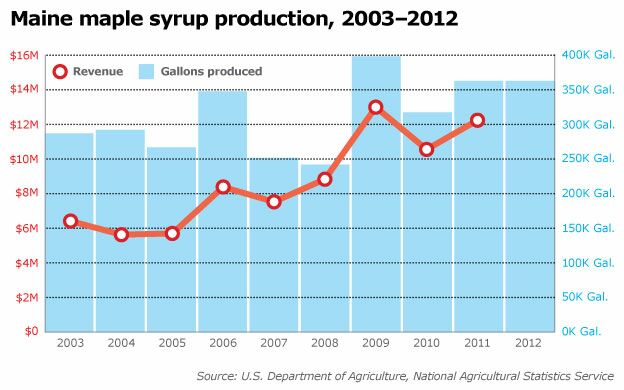Maine syrup makers brace for widespread variability
While most Mainers enjoy the kickoff of the state's maple season in late February or early March, Eric Ellis's syrup season kicked off in late January, with his workers beginning to drill holes and lay lines for the trees in Big Six Township, north of Jackman. The early drilling is due partly to the sheer size of the operation, says the Madison-based syrup processor; his production team taps some 80,000 trees to produce somewhere between 15,000 to 20,000 gallons of maple syrup.
But the early start comes also because it pays these days for maple producers to be prepared to catch an early run, Ellis says. He's been processing syrup for about three decades, long enough, he says, to see the season creep earlier into the calendar year.
“Over time, you certainly see that, whether it's this decade or three or four decades back,” Ellis says. “We're consciously starting a little sooner.”
Maine maple producers have had to contend with some unusual syrup seasons in recent years. While veteran producers are quick to point out that variability is part of the package when it comes to harvesting maple syrup, talk of climate change has become more common in the maple-producing community, especially after a very unusual 2012 season that saw temperatures spike to 80 degrees during a March stretch of the sap season. The heat wave caused havoc for syrup producers, some of whom weren't even prepared to start the season, says Kathy Hopkins, a maple syrup educator with the University of Maine Cooperative Extension.
“For a lot of people and some states, that was the end of the season,” Hopkins says. “They basically hadn't even started and it was over.”
Getting in the flow
A successful maple season depends on a delicate balance of warming days and freezing nights, and the balmy weather cut the sap season short. It was a terrible season for producers in the southern part of the state, while northern syrup-makers did better, but not great. According to U.S. Department of Agriculture statistics, while the state's maple producers added 30,000 new taps in 2012, overall syrup production flatlined in comparison to 2011, with 360,000 gallons of the sticky stuff.
“Our production was about 70%,” Ellis says. “We probably were much more fortunate than most sugar-markers.”
Agricultural officials have begun to warn that altered weather patterns will mean change might become the new norm for maple production in the United States. In 2010, researchers with the USDA Forest Service and Cornell University warned that rising temperatures caused by climate change were already affecting the sap season and will continue to shift production earlier in the calendar year. The research, which projects into the next 100 years, shows that there will be geographic winners and losers in the syrup industry if the expected warming trend continues and the sugar belt shifts north. Production will peter out in the southern range of syrup production, in places like Pennsylvania and northern Virginia, while some northern locales in Maine and Vermont might see stronger sap runs in the coming years.
State processors are already adapting to the earlier season, says Lyle Merrifield, president of the Maine Maple Producers Association.
“Ten years ago, if you tapped on Valentine's Day, that was plenty soon,” says Merrifield. “I personally know someone this year who made 22 gallons of syrup in January.”
USDA figures show that maple syrup production across New England was down 27% from 2011 to 2012. Not only do maple trees need warm temperatures during the day and below freezing temperatures at night during the sap season, they also need the ground to be frozen and snow-packed around their base to prevent them from warming too quickly. Last year the ground wasn't deeply frozen and there was no snow on the ground when the heat wave struck, Merrifield says.
Climate change is no longer being characterized exclusively by warming temperatures. Instead, scientists are warning of less predictable and more powerful weather events, including drought, that could ruin maple syrup production, says Brian Chabot, an evolutionary biologist with Cornell University's Maple Program. Sap is like the tree's blood, and good sap flow depends on the health of the tree. Maples are not that drought-resistant, Chabot says.
“If they're not growing, one would anticipate less sugar [will be] available,” he says.
This year, however, a deep snowpack and frozen ground won't be a problem, although maple producers who didn't tap their trees before the Feb. 9 blizzard might struggle to get ready for this sap season, as it can be difficult to lay and maintain sap lines in deep snow.
Innovations
While the New England region suffered a cut in syrup production last year, it experienced a record-breaking syrup season in 2011. While luck of the meteorological draw plays some part in the difference between a good year and a bad one, many of Maine's syrup producers are making their own luck during the sap season. They're preparing to start earlier and employing innovative new techniques to boost sap capture, says Merrifield.
Most prominently, many Maine producers, and even some hobbyists, are switching from traditional taps to vacuum lines, which capture more of the sap. The lines also keep sap flowing in suboptimal weather conditions, says Merrifield.
“It allows us to get sap when barometric pressure isn't quite right, and get something good out of what would be a bad season,” he says.
Many are also heeding the advice of recent research showing that keen attention to sanitation can pay off in increased yields, says Chabot. Researchers with Cornell and the University of Vermont have found that replacing vacuum lines and taps annually can cut down on the bacteria that can clog drilled holes.
Many producers also are turning to reverse-osmosis machines to remove 75% of the water in sap before the sap reaches evaporators. While that does little to boost sap production, it helps syrup producers keep fuel costs down, says Ellis, who is vice president of the Maine Maple Producers Association.
“In the maple syrup industry, staying on top of the technology is certainly the best way to keep ahead of increasing fuel costs,” Ellis says.
The Bacon Family Farm in Sidney has used many of these techniques in recent years. They use vacuum lines to connect their 2,500 maple trees, and reverse-osmosis to remove much of the water before the sap reaches evaporators. They've also kept a worker out in the maple stands during the sap runs to keep an eye on all the lines, says Shelley Bacon, co-owner of the farm.
“We've found that just by doing that, we're able to get more out of the woods than we ever have before,” Bacon says.
Syrup’s future
But even with the measures Bacon has taken to improve sap yields, syrup production was down by half in 2012, she says. While she believes that such variability in weather isn't unusual, some researchers are trying to predict what new weather patterns might emerge for future maple producers in the region, and to map out what producers can do to continue to produce syrup in the state.
Jenny Shrum, a doctoral biology and ecology student at the University of Maine Orono, is researching how to better define what temperature rises and weather variability will mean for sap flow, as well as possible remediation steps that can be taken to safeguard the state's maple industry. She's reaching out to some of the state's smaller producers to record data about weather and sap flow in their maple stands. The data then will be incorporated into a larger project trying to create national climate change models for Maine's microclimates. It also could shed light on what affects the sap season, from soil composition to annual rainfall.
As Shrum travels around the state and talks to maple producers, she's finding a level of enthusiasm for her research that she's never seen before.
“A lot of people tell me they're really excited about the research,” Shrum says. “As a scientist, you don't usually get that.”
Growing awareness of climate change might spur better planning, breeding and management of future maple trees. Shrum is collecting maple seedlings from warmer climates that she and other researchers will grow in a lab and at an experimental plot in Baxter State Park to see if they have genes that will help the trees better tolerate heat and drought than native trees. It's a kind of seed and gene selection that is more common in traditional agriculture than in tree breeding; the thinking is that Maine trees might not be able to adapt quickly enough to the changing conditions.
“Maple trees do not move fast enough for these translocations to happen naturally,” Shrum says.
Future maple producers might also want to take advantage of soil data to carefully plan and manage maple stands and maximize production, says Kip Kolesinskas, a regional soil conservation consultant with American Farmland Trust. Modern soil data collected from satellites can show the best places to locate future maple stands and how best to manage them to strengthen the trees and improve sap flow. Future maple farmers will need to think even more about locating their trees on well-drained and fertile soil on north-facing slopes that can protect the trees from heat, he says.
“Anyone who's managing [maple] forests, they need to be thinking very long-term,” Kolesinskas says. “You're looking at land acquisition.”
Such forward-thinking might pay off in the marketplace. In 2011, the value of maple syrup production was $12.2 million. Despite the variability of the sap season, maple syrup production has been a booming business, and the number of state licenses for commercial production has increased, says Hopkins. USDA statistics show that the price of maple syrup has increased by $1.10 per gallon from 2009 to 2011, the last year data was released by agricultural statisticians.
That price could increase as some states are knocked out of maple syrup production, and the predicted warming trend could make Maine maple syrup more valuable in the marketplace, says Shrum.
“We might be a bigger player,” says Shrum. “As far as the nation goes, we might be better poised.”
Craig Idlebrook, a writer based in Massachusetts, can be reached at editorial@mainebiz.biz















0 Comments